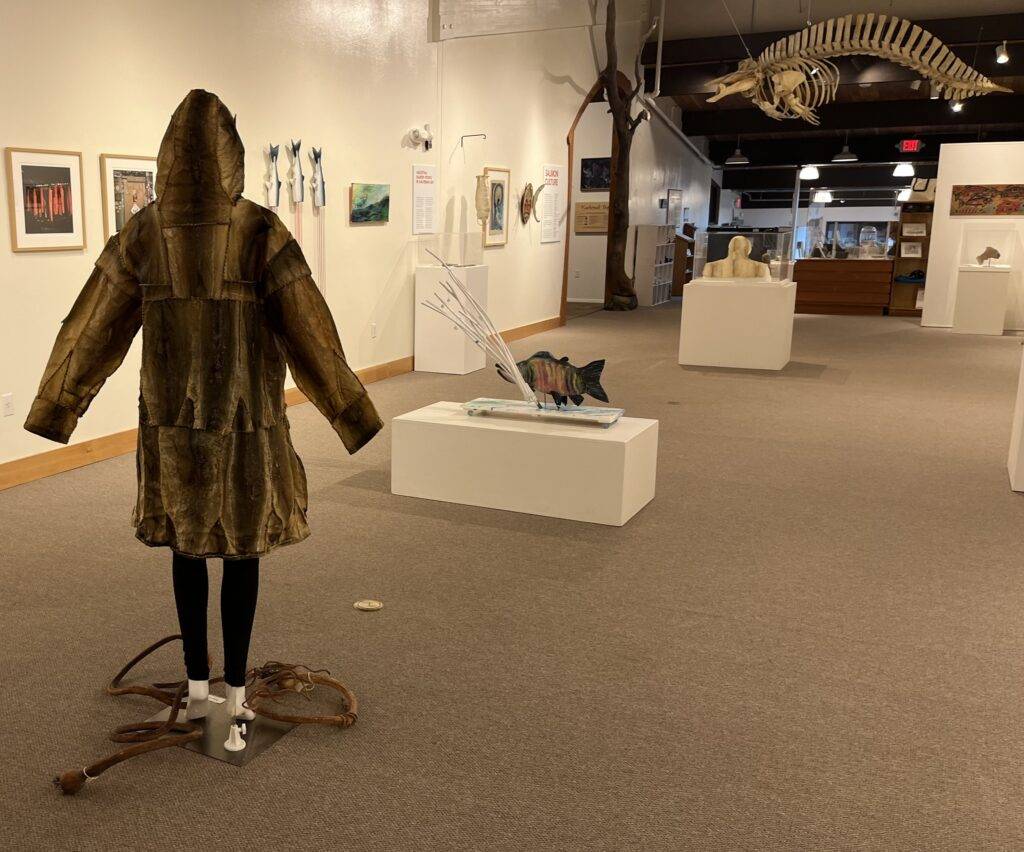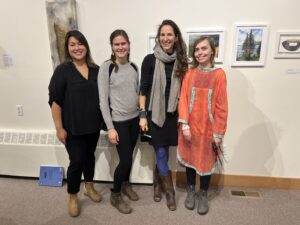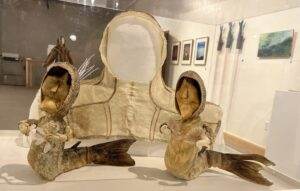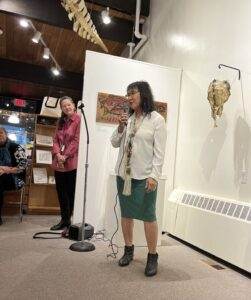Salmon Culture

The exhibition project, Salmon Culture, was developed at the Pratt Museum in Homer, Alaska with an Alaska Native curatorial team including Anna Hoover, Erin Gingrich, Drew Michael, Ilgavak Peter Williams, Rochelle Adams and Nadia Sethi as a curatorial mentor. Salmon Culture celebrates the connections between salmon and Alaska Native peoples through contemporary, historical and archaeological works of art. As shared by exhibit advisory circle member, Erin Gingrich: “Salmon are gifts, every single one a blessing. The continuity of their ancient cycle is something we owe to the past, present and future, not just our own future generations but the futures of all that have a part in this ecosystem.”
The exhibition team sought to use Indigenous curatorial methodologies to develop this project. This included using consensus models of decision-making, using inclusivity as a guiding principle when selecting works of art to include in the exhibition, and using mentorship as a learning tool. It was particularly important to the curatorial team to include Indigenous terms when possible in the exhibition texts. Members of the curatorial team gained experience with designing and installing exhibitions, writing text labels and hosting an exhibition opening. The curatorial team met virtually throughout the development of the project to build exhibition themes, select works of art and build the exhibition plan.
Thirty-one artists participated in the exhibition and seven new works of art were created especially for it. Artists involved included work with fish skin regalia, sculpture representing salmon, salmon-affiliated archaeological materials, salmon-themed masks, photography, glass-art, prints and paintings. An exhibition opening was held on October 7, 2022 with an artist panel including Rochelle Adams, Erin Gingrich, Anna Hoover and Sarah Thiele.
Erin Gingrich, Salmon Culture, curatorial advisory circle member
My experiences as a member of the advisory circle for the 2022 Salmon Culture exhibition was very enlightening and a wonderful practice for me to learn new forms of visual storytelling, to learn how to work with other artists, to learn how to design an exhibition layout and to learn what it takes to get a group exhibition completed from start to finish. In preparation for Salmon Culture the advisory group met several times for planning and to discuss curatorial decisions. This process was very grounding and provided us with time to understand each other and our goals for the exhibition. This led me to a new frame of mind and provided me with a new experience to share my work. It was wonderful to work as a team on this exhibition, it was very supportive in all the different ways that each of us was able to show up for this project and how we each could lend our specialties and skills to complete the exhibition.
I learned greatly about the process of selecting historical objects from a museum collection for exhibition, the process of delivering work to the exhibition location, the time and care that goes into written aspects of an exhibition and the process of working with a community of Indigenous artists that are so very connected but also so very busy. My time on the advisory circle for the 2022 Salmon Culture exhibition was a helpful practice for me and my work and has given me new skills with which to share my work andwork with others that share my narrative. Quyanaqpuk – Ana baasee’!
Ilgvak Peter Williams, Salmon Culture curatorial advisory circle member
I was moved by the process of having all an Alaska Natives team on the Salmon Culture advisory circle. The approach of being guided by cultural values was so welcoming, refreshing, healing and revolutionary. Because we worked together in this way, I think it was something that our ancestors would be proud of and opened the door for future generations and projects to build upon the ongoing work of decolonization and Indigenization. It was clear to me that what we did should happen frequently.
Some of the challenges for equity in museum work involve finances, resources, decision-making power, visibility, inclusion and access to all of these things. From my experience, I would say this project was groundbreaking. The challenge is to keep it going and find ways to continue making progress. In our experience, we learned that the cost of funding an exhibition is much higher than we anticipated. The logistics of shipping, receiving and borrowing from collections took a lot more work than anticipated. We learned this through trial and error but perhaps we can carry what was learned into future projects by budgeting more time and resources in future work.
I think that what we accomplished was really special. I hope that more institutions will support Indigenous people in similar ways by providing access and resources for similar projects. Quyana (thank you).



